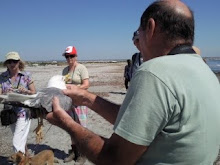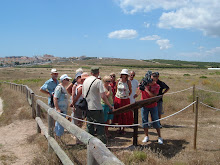Last week during our duty walk Jenny and I came across park workers trimming pine trees and using a machine to make them into pulp. The whole area looked much tidier, but we wondered if it mught encourage curious passers-by to stroll down to the water's edge, now that it's so visible!
Saturday, 2 December 2017
Sunday, 26 November 2017
Update on nesting boxes
This morning at La Mata Park the volunteers took down the Great Tit nest boxes, cleaned them out and returned them to the trees.
There are 12 boxes, each with a number at the base, to help with the monitoring of the birds. We have also recorded the co-ordinates of the boxes for ease of location.
Sunday, 5 November 2017
Update to meeting information
Please note we no longer meet in the Wine Growers' Association headquarters, mainly because it has been demolished!
We meet at 10.00am on the first Saturday of every month at the Park Headquarters: the white building called the Casa Forestal situated by the car park at the Park entrance.We look forward to meeting new volunteers as well as anyone interested in the work we do to help preserve this beautiful natural environment.
We meet at 10.00am on the first Saturday of every month at the Park Headquarters: the white building called the Casa Forestal situated by the car park at the Park entrance.We look forward to meeting new volunteers as well as anyone interested in the work we do to help preserve this beautiful natural environment.
Tuesday, 20 June 2017
Gull ringing
Audouin gull ringing 2017
At 0830 on 15 June 2017 five members of the
volunteers met at the Torrevieja Salinas to assist in the ringing of the
Audouin gull chicks. The Audouin gull is
still a relatively rare species and we are lucky to have an important population
of them in our area.
The format for the ringing was much the
same as last year. We were divided into four groups each containing a qualified
birdringer, a person to write down ring numbers, a person in charge of rings
and two people to find the chicks. In addition, and new this year, there was a
team of veterinarians attached to each group. Their function was to take blood
samples from a random selection of chicks in order to measure the level of
heavy metals in the chick which acts as a possible marker of marine pollution.
As well as placing a metal ring with its
unique number on one leg and a Darvic ring on the other, the ringer took
feather samples from some birds to measure the level of mercury (a significant
poison to man and animals and another marker of possible marine pollution). The
crown to tip of beak and tarsus (lower leg) was also measured in these chicks
so that if we are fortunate to catch any of these birds in the future we can
relate size to possible poisoning with mercury or heavy metals.
Two hundred birds were ringed in under two
hours (just as well, it was getting rather hot!) and following a gift of salt
from the manager of the saltworks we retired to a local hostelry for some
welcome refreshment.
Tuesday, 13 June 2017
Park concert photos
Thanks to Ana for sending these delightful photos of the children's choir
Photos by Antonio Ruiz Hurtado
Photos by Antonio Ruiz Hurtado
Wednesday, 7 June 2017
Habaneras in the Park
A heartwarming
event took place at the Natural Park of La Mata on Sunday 4th June when a concert
was given by the children of the Colegio Cuba, the
Inmaculada Concepción school, the Conservatorio Municipal and the
Consejaría Medio Ambiente.. In the setting of the Park and
in the open air it was the culmination of a year’s work by the school and the
staff of the Park in leaning about the natural environment and the heritage of
the habanera. These two elements are the
two treasures of Torrevieja which have been emphasized in other events this week. Some of the children dressed as pirates spoke
in unison of the history of the boats which went to and from Cuba, when the sailors
who could not read or write instead sang songs telling of the town they had been
to and what they found in Torrevieja, notably the pink lake.
The other
half of the group then sang several habaneras and ended with the brand new one
which has been written specially for this event and is called Laguna
Bella. It’s the first habanera ever to
have the words artemia and flamenco in the wording! First the children sang it accompanied by a
small group of musicians and then copies of the words were handed out and the whole
audience took part in singing this new addition to the collection of habaneras
of Torrevieja.
We all
enjoyed this opportunity, not just the proud parents of all the children who
took part.
The large crowd
of parents and several of the volunteers of La Mata were present at this lovely
event. Some of the Volunteers had also
attended on the Saturday when a large number of the public took part in an extended
visit to the Park, learning about it and its significance in our landscape.
It is hoped
by all these means that a greater number of people know about the Park and its treasures
and appreciate that we look after it as best we can.
Saturday, 1 April 2017
Vandalised nestbox
After
months of hard work and having only been sited a few weeks ago, one of
our nestboxes has already been vandalised. Culprit unknown-woodpecker,
rat, squirrel all in the frame at present.
Tuesday, 28 March 2017
Activity with CIAJ (Centro de Información y Animación Juvenil) Saturday 18 March 2017
On Saturday 18 March the volunteers entertained a group
of Spanish students to help them practice their English. Following a
short presentation about the history and function of the Parque and
the work of the volunteers we took them on a short walk around the
Parque to point out some of the features. We split into small groups
to allow all the students the opportunity to practice their English.
Conversations (all in English) between the volunteers and the
students were wide ranging and not always directly related to Parque
issues. Many of the students had never visited the Parque despite
living in Torrevieja and surrounding areas.
Both students and volunteers enjoyed the morning and
feedback from the students was extremely positive. In fact, they
requested that we make this a regular event.
Stephen
Visit to El Hondo North Gate 11 March 2017
On a slightly chilly (for Spain)
Saturday morning fourteen volunteers met at the North Gate of El
Hondo for three hours of birdwatching. Once again we were ably led
by Stephan and Els from the Costa Blanca Bird Club.
We
were immediately guided to the first boardwalk where we were treated
to excellent views of a Greater
Spotted Eagle
which posed in a palm tree for quite a long time and then graced us
by landing at the water's edge even closer to where we were standing.
Further stops were made at the other hides and viewing platforms
Altogether,
some thirty two species were identified including marsh
harrier, booted eagle, little bittern, glossy ibis, white headed
duck, pintail and blue throat. In
addition we were treated to an impressive display of jumping fish
(identity unknown, no fish experts present!).
After thanking Stephan and Els
we departed the park at 1130h.
Stephen
Saturday, 25 February 2017
Saturday, 18 February 2017
Siting of nestboxes
On a somewhat chilly Thursday morning a group of
intrepid volunteers ably assisted by the staff of Parque La Mata set
out to site the nestboxes which had been restored over the preceding
few months by other members of the volunteers.
First there was a preliminary talk by Justo explaining
how the aim of the project is to encourage Carbonero común (Parus
major, Great tit), a natural predator of the procesionario
caterpillar, to nest among the pine trees in the Parque and then we
set off into the Parque.
With the aid of members of the Parque work force to
clear any obstructing branches from the selected sites, all twelve
nest boxes were successfully sited. The position of each box was
recorded using GPS.
Over the breeding season the volunteers will monitor the
nestboxes for signs of nesting activity.
More
photos are available on Facebook
(https://www.facebook.com/Lagunas-de-Torrevieja-y-La-MataVoluntarios-368312283377134/?hc_ref=NEWSFEED)
Stephen
Friday, 10 February 2017
The Day of the Wetlands
As a
celebration of the Day of the Wetlands a guided walk in the Parque Natural of La Mata attracted a
group of 40 people, which included 5 of the Volunteers of La Mata, and several
children. We set off along the official route
and the guide explained to us what the signs on the side of the path indicate. We are asked to stay on the official route,
not to pick the plants, and above all to keep dogs on leads as there are
nesting birds on the ground at present.
The lake
water is particularly high at present due to the exceptional rain which has
fallen recently and it is hoped the nesting birds were able to move further up
the banks and not be washed away.
We saw how
new vines are propagated by using a cutting from an old vine which is then dug
deep into a hole so as to put out new roots.
At one time all the land from the Park down to the sea was vines until
buildings took over.
Our guide
explained the different plants and birds and at the end of the walk we had all
learned things we had not previously realized.
A most interesting morning in spite of the fierce wind and one we all
enjoyed.
Jenny Dodd, Press Secretary
Nesting boxes
An important
event was held on the 9th of February when new nest boxes were installed in trees
in the Natural Park of La Mata. These
nest boxes are intended to encourage the Great Tit to nest and breed in the
future. These little birds like to eat
the grubs of processionary caterpillars which are such a danger to animals and humans
alike. This year they have started
moving early and their nests can be seen in the pine trees. They look like a
loose ball of cotton wool. When they come down from the trees they line up nose
to tail and process, hence the name. A
small group of the Volunteers of La Mata has been busy renovating old nest
boxes and making new ones which were ready to be installed. A crowd of 14 of the volunteers followed the
Park employees into the woods where the nest boxes had to be hung in a specific
way. First of all they had to be quite high
up. Secondly surrounding branches had to
be cut away so that rats cannot get into the nest boxes. To further stop rats gnawing away the wood
round the small opening where the birds will enter, a metal plate has been
fixed.
The
Volunteers will have the task of monitoring the success of this project and GPS
positions have been noted so as to locate them all. A most successful project; now we await the
birds.
Thanks to Jenny Dodd for the article and photos
Sunday, 15 January 2017
Saturday, 7 January 2017
Processionary nest!
Watch out! Processionary nest spotted in the park today....keep your dogs away from trees, too!
Subscribe to:
Comments (Atom)





















































